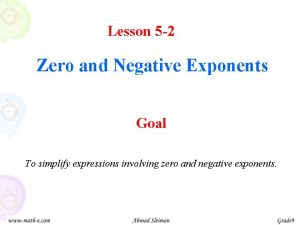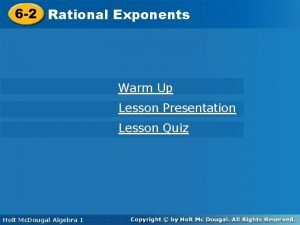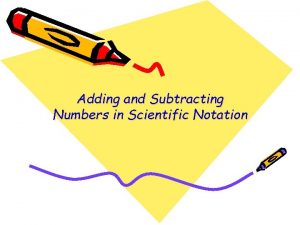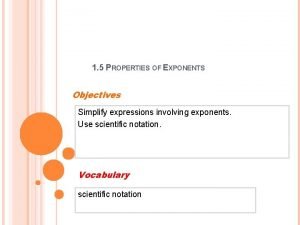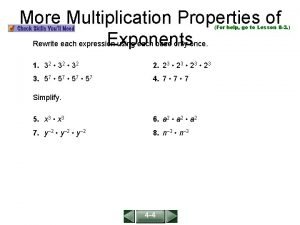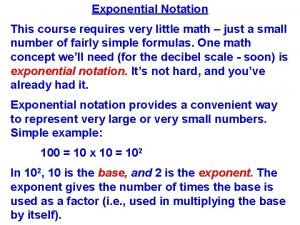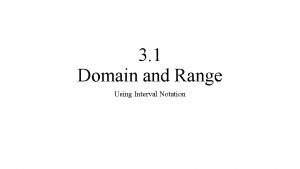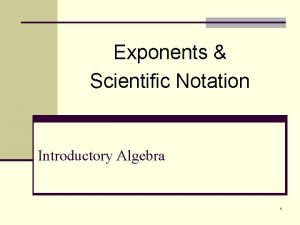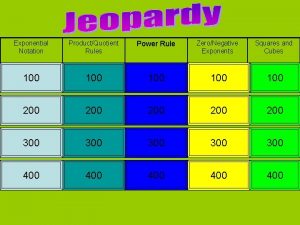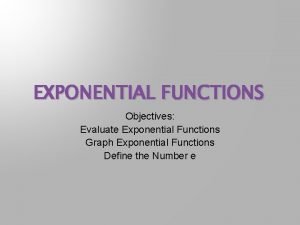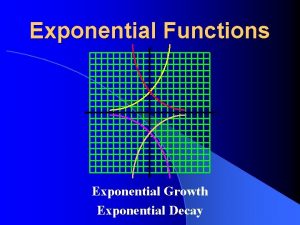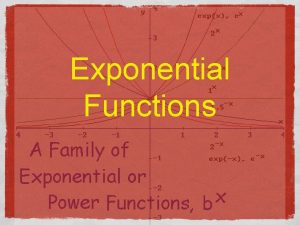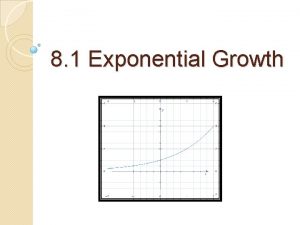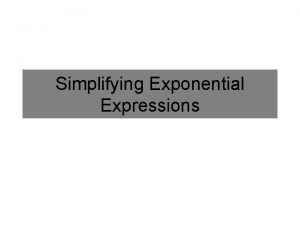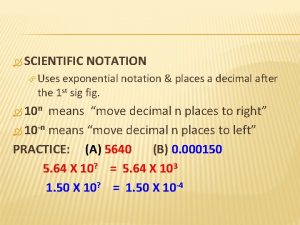Exponential Notation 1 3 I Using Exponents A

















- Slides: 17

Exponential Notation 1 -3

I. Using Exponents A. Vocabulary: ◦ Power – product in which the factors are the same ◦ Exponent – tells how many times the base is multiplied ◦ Base – the number that is multiplied ◦ Exponential notation – an expression that is written with exponents

B. Writing out an expression with exponential notation: 22 = 2 x 2 35 = 3 x 3 x 3 n 4 = n x n x n y 3 = y x y 2 y 3 = 2 x y x y (the exponent is only connected to the y, so that is the only thing that is expanded)

Examples: � 1. 54 � 2. b 3 � 3. 2 x 3 � 4. 12 y 4

C. Writing in exponential notation: 7 x 7 x 7 = 74 n x n x n x n = n 6 3 x m = 3 m 2 2 x y x y = 2 y 4

Examples: � 1. � 2. � 3. � 4. � 5. 9 x 9 x 9 y·y·y 4 xnxnxn 15 · x · x 10 x b x b

� Note: You can also “evaluate” problems that include exponents ex. y 4 + 3 for y = 2 24 + 3 2· 2· 2· 2+3 16 + 3 = 19 End of Part 1

II. Exponents with Parentheses � Up until now, all exponents were connected to only one number/variable, known as the base 2 y 5 � When an expression inside parentheses is raised to a power, everything inside the parentheses becomes the base (2 y)5

� A. To solve problems with exponents on the outside of the parentheses, you must connect/distribute the exponent to everything on the inside 1. (3 a)4 2. (5 y)3 3 4 · a 4 5 3 · y 3 81 · a 4 125 · y 3 81 a 4 125 y 3

� B. You can also do this same thing with evaluating: � Example: (4 m)3 for m = 2 43 · m 3 43 · 2 3 64 · 8 512

Examples: 1. (10 y)2 2. (6 m)3 3. (8 n)5 for n=2 End of Part 2

� C. When you have exponents both inside and outside of the parentheses: ◦ You must multiply the exponents (52)3 Multiply your exponents 56 = 15, 625

Examples: 1. (84)3 2. (k 7)5 3. (3 a 2)5

III. Exponents in Fractions A. If you have the same base in the top and bottom of the fraction, and they have exponents, you can simplify B. As long as they are the same base, you will take the top exponent and subtract the bottom exponent 35 Take the exponents and subtract… 5 – 3 = 2 33 32

Examples: � 1. 78 75 2. b 12 b 4 3. x x 3

� C. If you do not have the same base, you cannot subtract the exponents m 3 t 5 � D. If there are multiple bases, combine your like bases and leave the rest where they were Here are your like bases… subtract the exponents x 6 y 2 = x 3 z 4 x 3 y 2 z 4

Examples: � 1. 126145 124 2. a 3 b 8 b 2 c 9 3. 3 xy 12 y
 Lesson 5: negative exponents and the laws of exponents
Lesson 5: negative exponents and the laws of exponents Fraction exponents
Fraction exponents Scientific notation with exponents outside parentheses
Scientific notation with exponents outside parentheses How to add numbers in scientific notation
How to add numbers in scientific notation Section p.2 exponents and scientific notation
Section p.2 exponents and scientific notation Prime factorization of 450 using exponents
Prime factorization of 450 using exponents Simplify the expression
Simplify the expression Rewrite each expression using the properties of exponents
Rewrite each expression using the properties of exponents Exponencial form
Exponencial form Polish notations
Polish notations Engineering notation table
Engineering notation table Prefix postfix infix conversion
Prefix postfix infix conversion Reverse polish notation adalah
Reverse polish notation adalah Multiplying and dividing using scientific notation
Multiplying and dividing using scientific notation Domain and range using interval notation
Domain and range using interval notation Erd to uml
Erd to uml Using system.collections.generic
Using system.collections.generic Unit 25 special refrigeration system components
Unit 25 special refrigeration system components
